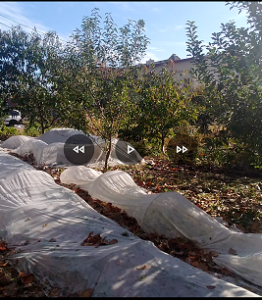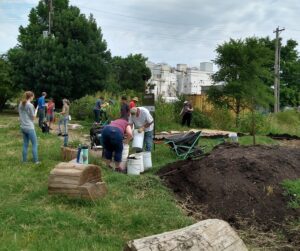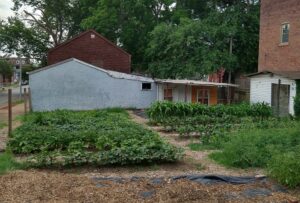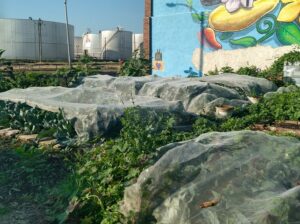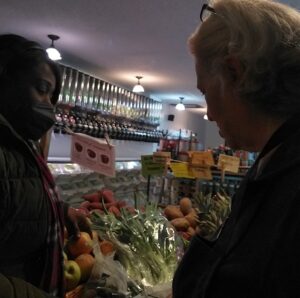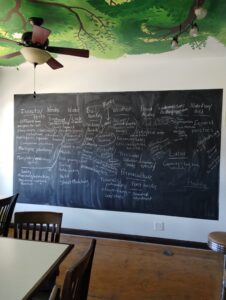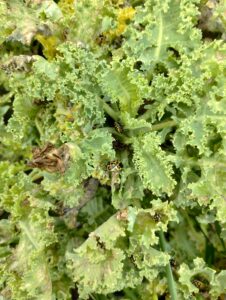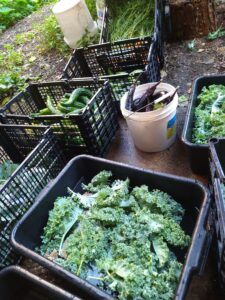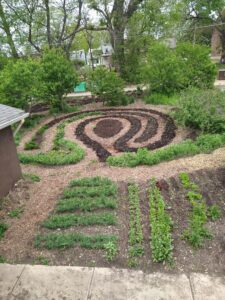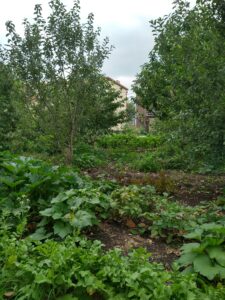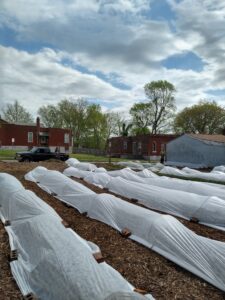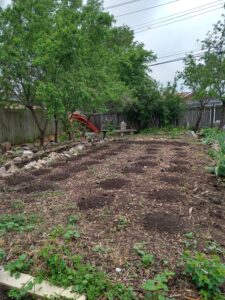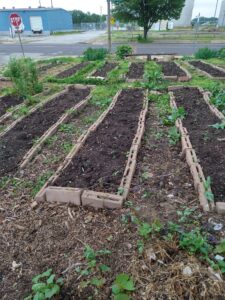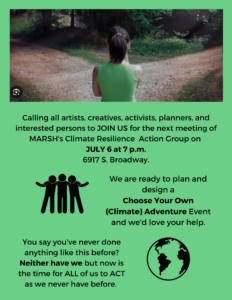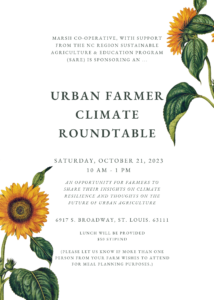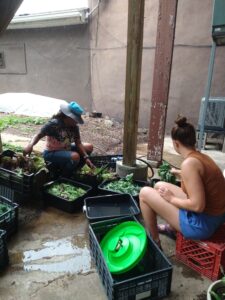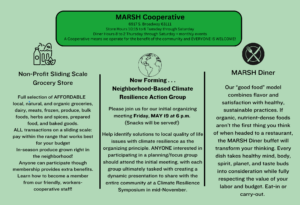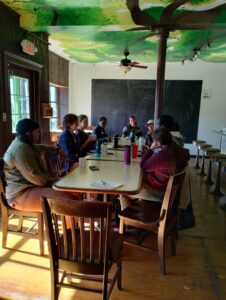Final report for FNC22-1344
Project Information
We operate a network of four local urban agriculture plots. The first is a one-acre food forest that was established in 2019 in partnership with Gateway Greening, the Carondelet Community Betterment Federation (CCBF), and a group of neighborhood farmers and volunteers. The second is a ½-acre patch attached to the MARSH Grocery location and was established in the spring of 2018. The third garden was a grassy double lot until spring of 2021 when MARSH developed it into a food production and is loaned to us for our use by CCBF. The fourth was a long narrow double lot that had been maintained by a former school teacher in the neighborhood and established with a wide variety of vegetables, flowers, perennial plants, and fruit trees. The gentleman donated the lot to MARSH in the spring of 2022 after a number of years of neglect.
MARSH attempts to grow any vegetables that can be produced in the St. Louis climate. We have no power equipment and all farm tasks are performed by hand and back. Two of the four sites are permaculture-based designs and the Quincy lot (the newest patch) will be developed in that direction as well though no agricultural chemicals have ever been used there. While not certified at this time, organic growing techniques have always been practiced 100% of the time. We use home-produced and city-produced compost to develop and enhance beds, and city water hydrants for irrigation.
The most pressing issue for the food system is impacts from climate change. It is incumbent upon this farming generation to work at the grassroots of food production among those populations that are most precarious and thus most vulnerable to climate effects. Beth Neff of the MARSH Cooperative seeks to develop strategies for climate resilience in a low-income neighborhood through a cooperative approach that supports the community economically and socially while exploring innovations in climate-responsive sustainable urban agriculture methods.
MARSH’s program model is based on the integration of food system components – a network of urban agriculture plots, a licensed kitchen, and sliding scale grocery cooperative – managed by the participants. This integrative approach localizes food resources, improves both economic and logistical access, advances positive health outcomes, promotes human agency, reduces ecological impact, virtually eliminates food waste, and builds community and social value through a relational economy. In partnership with Laura Belarbi and Laura Gatlin of the Food Patch, Beth Neff proposes to establish an expanded workers cooperative to farm four varied locations that will make more food available, test climate response strategies, and build a foundation for resiliency in a neighborhood that is most vulnerable to climate impacts.
FINAL REPORT ADDITIONS
The problem we are addressing remains the same from the first year of the grant project i.e. the application of a workers cooperative labor model for food production in response to climate change.
Our solution has been multi-pronged. First, we needed to establish the parameters of a “workers cooperative.” This required multiple conversations around issues of leadership, collaboration, democratic decision-making, knowledge and time resources, delegation, and personal/group goals. Second, we needed to educate about and then balance the concerns of food production with the overarching attention to both the pressures of climate change and the development of a plan to build resilience. Finally, we needed to envision multiple strategies for sharing our own experiences while creating formats for exchanging information resources with others.
Our research approach involved gathering information from the first grant year’s experiences and applying strategies for addressing the issues we identified in the second year. Education occurred both formally and informally, both ongoing and conclusively. We shared our project goals and outcomes on a daily basis with passersby at the gardens and with co-op members in the grocery store, with volunteers in the gardens and the kitchen and also with interns from local programs and universities in those same contexts, with community members gathered in meetings over the course of the growing season to discuss more general climate resilience, and then, finally, with farmers at our culminating Urban Farmers Climate Roundtable.
Our conclusions show that climate pressures are already urgent. Despite multiple strategies to address those pressures, food production has become even more challenging than it already was. Specific conclusions include:
- Permaculture-style food production (integrated plant communities, various micro-climates, increased biodiversity, organic soil management, locally-adapted species, etc.) will be essential to resilient food supplies. Row cropping, especially with uniform species, is the least resilient model for healthy food production, both in terms of yield and environment, and human health.
- Physical protection strategies are most successful i.e. mulch for weeds and moisture retention, insect screens and row covers for bugs, shade during the heat of the day for both plants and humans.
- Expectations may have to adjust as time goes on. It may not be worth the investment of time, labor, and money to grow all the crops we’ve come to expect throughout the season. The food patch, in particular, showed the increased resilience of locally-adapted fruit varieties, which may mean shifting diets to fruits and vegetables with which we are presently less familiar but are less susceptible to climate pressures.
Our worker cooperative model helped us focus on what might be the most critical aspects of resilience to climate change: the human element. If we want more farmers growing nutritionally-dense foods that are available to the most vulnerable populations in urban areas, the existing default of individual farmers growing produce on large tracts of land will not achieve our goals. Instead, if we are able to work as a community-based group guided by climate values, we will be more likely to:
- grow the foods that are both successfully adapted and that people will want to eat (and learn to prepare)
- manage diverse plots across the urban landscape that will make food significantly more accessible
- involve far more people in food production and bring them closer to the process, thereby improving quality of life in each neighborhood
- make food production less stressful and exploitive (especially under high heat-pressure conditions) by spreading out the responsibilities to a larger group and making well-being of the labor force a priority
- create models for flexibility and adaptability as conditions change
- avoid artificial or centralized food shortages, labor shortages, price instability, and ecological devastation
- grow more and better food
Our project seeks to strengthen an existing integrated food system using principles of climate resilience. We plan to accomplish this objective by:
- Hiring and training a locally-sourced worker cooperative team to collaboratively farm four neighborhood plots in order to make a reliable and accessible supply of fresh produce available at a sliding scale cooperative grocery.
- Comparing the four locations to apply and evaluate methodologies for responding to climate pressures (heat, insects, weeds, moisture levels) while also attending to social pressures of climate change and appropriate responses.
- Building a climate resiliency template to initiate discussion at a workshop hosted by MARSH.
Research
Our two-year project was designed to strengthen an existing integrated food system using principles of climate resilience. We planned to accomplish this objective by:
- Hiring and training a locally-sourced workers cooperative team to collaboratively farm four neighborhood plots in order to make a reliable and accessible supply of fresh produce available at a sliding scale cooperative grocery.
- Comparing the four locations to apply and evaluate methodologies for responding to climate pressures (heat, insects, weeds, moisture levels) while also attending to social pressures and appropriate responses.
- Building a climate resiliency template to initiate discussion at a workshop hosted by MARSH.
The first step for the project was to hire the members of the cooperative team. We ended up rehiring several workers from the previous gardening season whose experience made them excellent candidates to help with planning for the new season. We hired three garden workers and also used funds from another grant to hire additional assistance at the Food Patch food forest where two of our collaborators focused their energies.
All members of our team reported:
- improved diets based on access to fresh produce
- increased interest in cooking at home
- desire to gain more knowledge about gardening and cooking
- higher quality of life due to decent wages and access to lower cost (or free) fruits and vegetables
- appreciation for group decision-making processes
- a sense of accomplishment
Everyone also expressed high levels of fatigue with the physical demands of farming, especially in extreme heat, and ambivalence about farming in general due to these stresses.
We selected a number of seed varieties based on their stated insect and disease resistance, heat tolerance, adaptation to low moisture levels, pollinator potential, and capacity as companions to other crops. We then added a new compost layer to all planting beds, aiming for a depth of no less than 12 inches of friable soil and nutrient access. We laid out a garden plan that would allow us to test the health of plants in a variety of environments, and noted any specifics of growth habit, production, insect or weed pressure in each of the environments. Due to recent experience with certain problematic insects (harlequin bugs, squash beetles, aphids), we installed a combination of row covers and insect screens to susceptible crops and also tested some mulching strategies (leaves, black plastic, landscape fabric, decayed chips, etc.)
Though we will really need the second year to make extensive useful conclusions, we are able to report the following:
- Due to a very hot summer, our most successful crops were those that experienced a bit of shade, more than we have come to expect is suitable for vegetable crops. Our best plot was the permaculture design garden where we were able to direct plant fall seed crops (unsuccessful in other locations due to high soil temperature and dryness) and we were able to maintain greens such as lettuce and kale through the summer.
- Though normally used to raise temperatures, we discovered that row cover actually provided a bit of shade while helping to protect plants from insects. Unfortunately, the use of row cover in early fall created a serious aphid problem.
- Heat stress to young plants at the food forest was somewhat catastrophic. We lost a couple of young trees, all of the blackberries, and a few grape plants. We are aware that a more extensive and frequently scheduled watering system will be critical to the ongoing success of the food forest. The present system, though mostly underground, requires hoses from a city hydrant which have to be taken out at the beginning of watering and brought back in at the end due to a high rate of vandalism in the neighborhood.
- Insect screen was highly successful at protecting crops from early insect pests, less so as the season progressed (also, we discovered, no impediment to ground hogs that ripped through the screen!)
- We will experiment a lot more next season with companion planting as we noted some early success with marigolds and calendula in combination with greens (provided shade, moisture retention, and a bit of insect protection) and radishes with cucumbers and zucchini.
- All mulches were successful at improving moisture retention and reducing weed pressure. None had any noticeable influence on insect populations. Weeds were far less of an issue in the gardens with the most history in exact relationship to the amount of compost over time (5-year garden, virtually no weeds: 2-year garden, some grass invasion and the need for one or two thorough weedings; 1st-year garden for us – this garden had been neglected for a number of years before we took it over for the first time this year – high weed pressure.) We will focus our attention on mulching heavily in the newest garden next year.
Our last objective, building a climate resilience template, will happen in the second year of the grant.
FINAL REPORT PHOTOS
Measurable analysis of project outcomes were mostly focused in this first year of the grant on agriculture and food infrastructure. We wanted to know how the benefits of local urban agriculture would be distributed and at what scale.
Equitable land access was addressed by providing fair-wage positions to members of the community who described themselves as low-income and/or food insecure. With this grant and the addition of a small amount of other funding, we hired four farm workers who would otherwise have likely had no access to land and expressed an interest in farming in the future. We also welcomed volunteers on a weekly basis who inquired about such opportunities at the grocery store or contacted us through the Food Patch. Throughout the season, more than 150 volunteers came out to the gardens one or more times. All food grown at the Food Patch is available to the public free of charge. Our other three gardens provided free food to neighbors on a regular basis, either through word-of-mouth “help yourself” channels or by placing produce on the sidewalk after each day’s harvest (cracked melons, slightly insect-damaged tomatoes, etc.)
Food access was directly measured by sliding scale transactions at the grocery store that included produce grown by MARSH. Over the course of the season, we provided $5106 in subsidies through 355 transactions that included MARSH produce. Total sales of MARSH produce equaled $11,411. This sales figure does not include the produce that was distributed through our CSA program which supported 35 member families over 26 weeks.
We will seek to understand more about strategies for maintaining food supplies under climate pressure and increased climate resilience in the second year of this grant.
FINAL REPORT ADDITIONS
While the first grant year was devoted to working as a farmer cooperative in establishing what we hoped might be some climate resilient food production strategies, we committed, in the second year, to tweak those strategies and to propose a climate resilience template. What follows is the result of our own research, ongoing conversations with other growers and patrons, biweekly gatherings of community members interested in climate resilience, and critical input from our culminating Urban Farmer Climate Roundtable.
All of the conclusions listed above for the first year’s growing season apply equally to the second year. In addition, we actively rotated crops out of problem areas, placing brassicas and squashes, for example, in completely different gardens several blocks away as a potential control strategy. As in 2022, row covers and insect barriers were highly successful initially and greatly reduced in effectiveness as the season progressed. Instead of trying to maintain existing stands of brassicas (all extremely susceptible to harlequin beetles and including crops such as broccoli, cauliflower, broccoflower, cabbage, kale, bok choy, etc.), this year, as soon as insect populations reached unacceptable levels, we pulled the plants and completely removed them from the site to a community compost facility. Any fall plantings of similar crops were immediately inundated regardless of physical protection, as apparently the bugs were hatching from the soil. Sadly, it seems that all residual vegetation will need to be removed from the plots - which certainly wouldn’t have been part of our sustainable growing techniques in the past! - before those crops can be grown again.
We used row cover much more extensively in the second year and learned that plants can adapt to the slightly increased temperatures quite well as long as the row cover is put on immediately following planting (adding it later stressed the plants too much). In fact, even crops that wouldn’t normally require covering such as carrots and beets thrived under row cover (we planted them kind of accidentally in a row with mustard greens and turnips that we DID want to protect.)
We also expanded our use of companion plants with some success. Cucumber beetles were almost non-existent in plantings where we mixed in radish seeds and allowed the radishes to mature all the way to flowering. We planted eggplants with a mixture of parsley and cilantro and observed very few flea beetles. Leeks and zucchini made good companions as well, the patch resisting total squash bug devastation until fairly late in the season. We also tested a number of summer squash varieties and found a variation in insect resistance that will be worth further exploration (and would likely be unique to particular locations.)
We selected varieties in the second year that were specifically noted to be heat tolerant. While there was still a pollination gap - and thus a production gap later - for tomatoes and peppers during the hottest part of the year, we felt like the gap was narrower than it had been in the first season. Once again, some of the “preferred” varieties (beefsteak-type tomatoes, California-style peppers, etc.) were far less adaptable, with yellow salad-type tomatoes and sweet yellow peppers far out-producing their more heat-vulnerable cousins.
With many of the same team back for a second year, most processes went a lot more smoothly and work occurred far more independently. While production and sales remained pretty much the same, we produced a wider variety of vegetables and, with some increased efficiency, had more time to create recipe cards and booklets, work with the grocery and diner teams to predict upcoming crops and include the produce in diner menus, and also to provide opportunities for the team members to rotate through various tasks to preserve enthusiasm and job satisfaction. It is also important to note that working with climate resilience as a priority is not necessarily immediately intuitive. While many of the strategies and techniques differ little from established sustainability principles, it is noticeably difficult to maintain focus on immediate goals and prefigurative planning and operations at the same time. This takes practice and regularly articulated motivation and also the ability to hold values when confronted with pushback or just widespread difficulty making an unknown future a central principle.
Our Urban Farmers Climate Roundtable resulted in some invaluable input on climate resilience. Here are the highlights of the discussion.
The challenges and issues are featured across the top of the image above. These include:
Pests - insects such as harlequin bugs, squash bugs, aphids, etc. and mammals such as moles, squirrels, and mice. Observations included extreme increase in pests, especially harlequin bugs and difficulty of control, especially since species and quantities vary from year to year. Control strategies include trap crops, rotation, row covers, individual barriers, companion plantings, and multiple and successive plantings.
Weeds - specific pests include bindweed, johnson and burmuda grasses, poison ivy, and significantly more rampant amounts of pokeweed, smartweed, pigweed, purslane, and chickweed. Controls include cover crops, burlap and other mulches, wood chips, sheet mulching, compost applications.
Fertility - Issues include sources of significant compost and poor city soils, including toxicity. Solutions include vermiculture, cover crops, homemade compost, chickens and rabbits, possibilities around human waste recycling.
Environment - the biggest concerns here were pesticide drift and soil, air, and water toxins, especially in urban environments. No obvious solutions other than advocacy and policy changes, soil testing, and raised beds.
Weather - Climate change impacts include heat, weather unpredictability, drought or deluge. Solutions include friable soil, access to irrigation, shade, and garden diversity, especially including identifying and planting less climate-susceptible varieties.
Food access and nutrition - urban areas are particularly susceptible to food apartheid, financially-limited access, and the pervasiveness of poor-quality food. Concerns related to climate change included increased precarity, weather-related food shortages, and higher food costs. Solutions included more urban ag grants, vouchers for seniors and children, building a more sustainable urban food system, planting greater varieties (particularly fruits and vegetables culturally appropriate to urban populations and locally adapted), more urban access points for locally grown food. It was also mentioned that food access can be a transportation issue and so is connected to urban infrastructure including public transportation, safe pedestrian and bicycle travel, and time.
Land access - This is both an historical racism issue and a labor capacity issue. Possible solutions include cooperatives, grants which allow land purchase, better municipal policies around land acquisition and use, community projects around such activities as fruit tree planting, and outreach.
These examples and many more lead us to the following core concepts of a climate resilient template:
- Effective insect mitigation relies on highly fertile soil, physical barriers, debris removal, and variety selection.
- Effective weed mitigation relies on deep compost and highly fertile soil, specific companion plantings, and selective mulching.
- Heat adaptation relies on variety selection, strategic shade, interplanting of tall and short plant species, early morning labor hours, and plentiful water (for both humans and plants).
- Field organization relies on a shifted emphasis from pure production to experimental techniques involving species variety, planting locations and density, design principles, and climate prioritization.
- Nutritional adaptation relies on broader dietary flexibility and multiple species plantings.
- Healthy work environments rely on short stints in the cooler hours of the day, rotation of responsibilities, and democratic decision-making.
- More general climate resilience relies on strong community involvement and communication, teamwork, and physical and emotional support.
- Food security in a climate-stressed environment relies on multiple and varied community plots throughout the neighborhood; multiple, decentralized, and creative outlets for food access; cooperative economic structures that de-emphasize profit and emphasize fair labor models; biodiversity; compost production; broader/frequent education making the connection between local sustainable food production and climate resilience; policy support for climate resilient projects and activities; funding for climate-smart projects and practitioners.
Educational & Outreach Activities
Participation Summary:
The educational and outreach aspects of our project will all occur in the second year of the grant. We intend to develop extensive outreach materials to communicate results, invite participation, and inform the public and the media of our endeavors.
FINAL REPORTS ADDITIONS
The primary areas of outreach include the following:
- Community Farmers - In May of 2023, our team and a group of volunteers created a volunteer program and calendar. Access to the calendar was made available through our social media platforms (mostly Instagram and Facebook) and through our biweekly newsletter. Volunteers could sign up directly on the calendar or contact us directly to find out when and at which garden we would be working on any given day. Interest was high and became unwieldy enough that we shifted our garden calendar to offer slots only on Tuesdays and Fridays, especially from mid to late season when harvesting and processing were the highest priorities. About 25 co-op members helped in the garden over the course of the season with usually one or two each day assisting our hired team. Many volunteers were also working at other gardens, which allowed for a dynamic exchange of ideas and information. Finally, a total of approximately 100 community volunteers participated in five work days at the food patch and at our Quincy garden.
- Interns - For the last three years, MARSH has participated in a partnership with the Logan University Masters in Dietetics program. Students at Logan perform rotations for their degree, and a total of seven interns spent anywhere from one to three weeks working alongside our team in the gardens and kitchen at MARSH. In addition, we provided on-site workshops for students in the sustainability program (about 20) and the urban design program (6) at Washington University, and for fellows of the Coro program spending the summer in St. Louis (14).
- Programming - Members of our team were invited to visit and describe our project at A Red Circle, Rustic Roots Sanctuary, The St. Louis Ethical Society, Carondelet Business Luncheon, the Women’s Peace Initiative, among others, reaching approximately 400 community members. We also hosted several school groups.
- Climate Symposium - In April, 2023, our team designed a bulk mail postcard that was sent out to everyone in our zip code (approximately 6200) households, inviting them to participate in monthly climate discussions to design a neighborhood-based resilience project. After the first meeting in May (23 attendees), the group decided to meet bimonthly in the hopes of planning an event for November. Over the course of the summer, attendance varied but averaged around 16 attendees at eight meetings. These included citizens, farmers, representatives from community organizations, our alderwoman, representatives from the city’s planning department, students at various area colleges and universities, some of our Logan interns, co-op members, and others. The group decided to expand focus to five categories of concern: food, river restoration, biodiversity, transportation, and energy. The process resulted in a google doc resource for each category. MARSH also joined the Thriving Earth Exchange which assigned us a program manager to pursue our climate goals and held three zoom meetings for team leaders to support and inform climate resilience projects in eight cities across the country. Though we were not able to complete planning in time for a climate event this year, we are still hoping to use the connections and momentum to continue this ongoing effort next year.
- Urban Farmers Climate Roundtable - As the culmination of our SARE-supported project, we invited a total of approximately forty-five farmers and agricultural professionals to attend an Urban Farmers Climate Roundtable in order to both report on our ongoing research and receive input about experiences addressing climate change from others. 16 attendees met on October 16 for a morning session, lunch, and an afternoon session. Invaluable information was gathered and then shared on our website, social media, and in our newsletter and also made available to attendees. (Several attendees now plan to apply for SARE grants 😀)
More can be found on our website: https://marshlifeart.wordpress.com/
Learning Outcomes
The most significant outcome of this project has been the initiation of important conversations throughout the community about climate resilience. The first year has given us innumerable opportunities to explain to neighbors who visit the gardens and patrons at the grocery what this project entails and what our hopes are for the coming year. High points include:
- Connecting with an extensive network of local farmers who are interested both in evaluating some climate strategies on their own farms and learning from others about their processes.
- Connecting with agricultural and environmental professionals who will be interested in participating in the planning and execution of a Climate Symposium at the end of 2023.
- Connecting with MARSH Co-op patrons who are already members of the co-op or who have signed up for our newsletter in order to receive regular updates about programs and events over the coming year.
- Connecting with neighbors who are interested in participating in the development of a grassroots climate resilience project.
- Connecting with artists, creatives, organizers, and activists who will help build communication networks and develop materials for next year’s symposium.
So often, the work that farmers do is out of the public eye. Food seems to just magically appear on grocery shelves with little thought to how it got there until there is some interruption in the supply or prices go up. Our gardens and grocery store bring food directly into people’s consciousness, especially with the opportunity to discuss ways in which more people can participate in production, supplies can be more secure, access to healthy options can be improved, and growing methods can be more sustainable. This project effectively integrates the production and the consumption of food, creating more agency and awareness for everyone involved, and creates a model for expanding the roles and responsibilities in maintaining a fair and ecologically-sound food system.
Project Outcomes
We are members of a working group that has applied for partnership grants together and meets monthly to discuss food systems issues in our region under the organizational umbrella of Solidarity Economy STL. An exercise over the summer asked each participant (there were 8 farmers there) to name the top two issues that their respective farms/organizations would like to see the working group focus on. I was the only person who mentioned climate resilience in the initial conversation, but, since then, I have had conversations with almost everyone in the group about this SARE project and what we're hoping to do next year after gathering research results and creating a network of participants. Everyone I spoke to wants to be included in that process, plans to conduct some type of climate-related research on their own farms in the coming year, and is excited about meeting together to discuss and evaluate the results of that research next fall. This feels to us like a great example of both grassroots organizing AND the value of showing rather than just telling. Also, everyone who worked on the project this year is excited to apply some of the strategies we learned to next year's planting. There is really nothing more inspiring than having a solid plan and seeing it come to fruition!
FINAL REPORT ADDITIONS
The second year of our project provided many more contacts with community members and other farmers through our climate meetings and our Farmers Roundtable. Even though everyone who participated in the Roundtable is a farmer, the event brought together a number of folks who would not have met under other circumstances. More than half of the group stayed for several hours after the event was scheduled to wrap up and many people exchanged contact information. There was a great deal of interest in continuing to explore the issues that were identified during the event and a strong commitment to work together in shared understanding that a sense of purpose and collaboration can go a long way toward mitigating the fear and helplessness around issues too large for us to impact alone.
It really meant a lot to us to be able to express our passion for both sustainable production and community resilience with SARE's support. We developed a framework for our community climate resiliance dialogue that others are welcome to adapt to their community needs.
Neighborhood Climate Event Text
There was a great deal of interest in continuing to explore the issues that were identified during the event and a strong commitment to work together in shared understanding that a sense of purpose and collaboration can go a long way toward mitigating the fear and helplessness around issues too large for us to impact alone.
